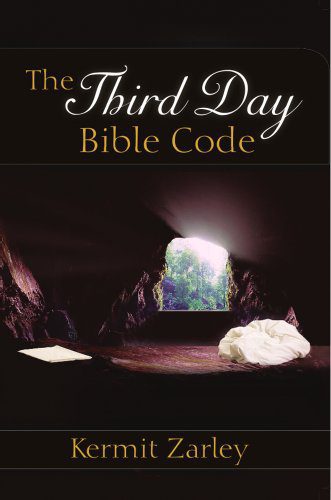Tonight, CNN presented a one hour television documentary special entitled “Finding Jesus: Faith, Fact, Forgery.” I thought this title was inappropriate because the entire episode was about whether or not the Shroud of Turin is the burial cloth of Jesus. Thus, the title should have had “Shroud of Turin” in it or the like. CNN did some advertising of this special, so I think they were a bit deceptive about whole thing. They interviewed some scholars, including Ben Witherington III who is a friend of mine.
I am always surprised by the attention given the Shroud of Turin by many people who supposedly believe the New Testament gospels are historically authentic. If you believe what the Gospel of John says about Jesus’ burial and his disciples examining his empty tomb, then you should believe the last word in the title of this documentary, that the Shroud of Turin is a “forgery.” Thus, there is no need to do radiocarbon dating (which dates it to Medieval times) and other scientific testing of this supposed shroud of a crucified man to learn whether or not Jesus’ body could have been wrapped with it. The Gospel of John clearly reveals that it wasn’t.
The Shroud of Turin is a single, fourteen-foot long by three-and-a-half-foot wide rectangular-shaped linen cloth that supposedly was discovered, or at least first surfaced, during the fourteenth century. It seems to bear the blood stains of the body of a crucified man as well as his face. It is kept secure by the Catholic Church in Turin, Italy, and that is why it is called the Shroud of Turin. Many Christians have believed that it is the original burial cloth of Jesus, thus supposing that his dead body was wrapped with a single burial cloth. That’s why it cannot be the remains of the burial wrappings of Jesus of Nazareth, at least according to the Gospel of John. When you see these television documentaries about the Shroud of Turin, and there have been several, they invariably always avoid these biblical details.
In the NRSV, the Gospel of John says that early Sunday morning, after Jesus had been buried Friday afternoon, “Mary Magdalene came to the tomb and saw that the stone had been removed from the tomb” entrance (John 20.1). Comparing the other three New Testament gospels, Mary accompanied several other women there, at least four. She then ran to tell the Apostle Peter and “the other disciple” (v. 2), who presumably was the Apostle John. She reported to them, “They have taken the Lord out of the tomb, and we do not know where they have laid him” (v. 2). The “we” refers to the other women who accompanied her to the tomb. By “take” she likely means grave robbing, though they could have thought of the gardener placing the body somewhere else. Peter and John then ran to the tomb.
Comparing the other gospels, it appears that the other women had left the tomb before Peter and John arrived there. The Gospel of John then says, “the other disciple outran Peter and reached the tomb first. He bent down to look in and saw the linen wrappings lying there, but he did not go in” (vv. 4-5). Since it was a hewn tomb with a tombstone guarding its entrance, Jesus’ dead body customarily would have been placed on a hewn ledge about knee high. Thus, the abandoned “linen wrappings” whould have been “lying there” on the ledge.
We next read, “Then Simon Peter came, following him, and went into the tomb. He saw the linen wrappings lying there, and the cloth that had been on Jesus head, not lying with the linen wrappings but rolled up in a place by itself” (John 20.6-7). This report provides two physical evidences which clearly deem the Shroud of Turin a fake.
First, Jesus’ body had not been been wrapped with a single grave cloth, as the Shroud of Turin; rather, the Gospel of John relates four times about “linen wrappings,” which is always plural, so that even the body itself, disregarding the head, had been wrapped with multiple clothes (John 19.40; 20.5-7). The Greek text has othonion/othonia, which means “sheets.” Could they have been “strips” of cloth as the Egyptians did? It should be noted that Jews, like Egyptians, were very particular about how they prepared human corpses for burial. Jews likely wrapped such bodies with several strips of cloth, thus not a single cloth. The main reason was that they interspersed spices with layered, multiple wrappings in order to further preserve the body from decay. A single cloth the size of the Shroud of Turin with spices could not possibly have preserved a dead body as long as multiple cloths with spices could have.
Joseph of Arimathea and Nicodemus together had prepared Jesus’ corpse for burial by sprinkling 65-75 pounds (the NRSV says “weighing about a hundred pounds”) of an expensive “mixture of myrrh and aloes” among the linen strips “according to the burial custom of the Jews” (John 19.39-40). They could not have done this with such a large amount of spices with the Shroud of Turin. And such a single cloth would have been more difficult to purchase in the marketplace than much smaller sheets or strips. Plus, multiple sheets or strips would have been much easier to wrap the body with than the Shroud of Turin.
Second, Peter entered the tomb first and “saw the linen wrappings lying there” and “the cloth that had been on Jesus’ head, not lying with the linen wrappings but rolled up in a place by itself” (John 20.6-7). This detail about the body wrappings and headcloth lying separately is most significant concerning the Shroud or Turin, but especially regarding Jesus’ resurrection.
I just finished and posted on this blog the third of a three-part review of Dr. Bart Ehrman’s book entitled How Jesus Became God. Ehrman is the best-selling Jesus researcher in the U.S. He is a professing agnostic and also an apostate from evangelical Christianity, yet a professor of the New Testment and the history of Christian origins. He claims in this book that there is no evidence reported in the gospels which indicates that Jesus really did arise from the dead. He says (p. 143), “belief or unbelief in Jesus’s resurrection is a matter of faith, not of historical knowledge.” He also says (p. 173), “it is not the historical data that make a person a believer.” Not so for the “other disciple,” who was probably the Apostle John. For we next read of him, “Then the other disciple, who reached the tomb first, also went in, and he saw and believed; for as yet they did not understand the scripture, that he must rise from the dead” (John 20.8-9).
So, John “saw and believed.” He therefore was the first disciple to believe in Jesus’ resurrection. It is often erroneously reported that Mary Magdalene was the first disciple to believe in Jesus’ resurrection. For, soon after Peter and John departed from the tomb, the Gospel of John reports that Mary returned to the tomb and there became the first disciple to see the risen Jesus. He talked to her and gave her a message to give to his male disciples (John 20.11-18). So, she returned to the house to tell the disciples, “I have seen the Lord” (v. 18). She is therefore sometimes called “the apostle to the apostles.” That is all well and good except that she also is often perceived wrongly as the first to believe in Jesus’ resurrection. John was the first to believe.
What did John see that caused him to believe Jesus had risen from the dead? He saw what the text reports immediately prior–“the linen wrappings lying there, and the cloth that had been on Jesus head, not lying with the linen wrappings but rolled up in a place by itself.” Recall that Mary had told Peter and John, “They have taken the Lord out of the tomb.” Thus, when Peter and John arrived at the tomb, entered, and looked around, they would have been thinking about the possibility of someone having taken the corpse out of the tomb. In the Roman Empire, grave robbing at that time was a crime punishable by death. But what John saw convinced him not only that no one had taken Jesus’ corpse out of the tomb, but that Jesus had risen from the dead and exited the tomb on his own. How so?
First, John probably reasoned that a grave robber or robbers would not have taken the time to unwrap the multiple, layered, linen wrappings and thereby subjected himself or themselves more readily to being noticed and perhaps arrested by Roman authorities. Furthermore, what purpose would have been served for a robber, robbers, or the gardener to remove the wrappings? And even if robbers had removed them, the robbers likely would flung those wrappings wherever, not bothering to roll up the face cloth neatly, and gotten out of there as fast as possible to avoid capture.
Second, a robber or robbers would not have taken more time to carefully roll up or fold the separate head cloth and then lay it to one side, separate from the bodily wrappings.
Third, since more attention had been given to Jesus’ condemnation and crucifixion than to a usual crucified criminal, Jesus’ bared face would have further endangered the robber(s) mission as they carried Jesus’ body away.
Such reasoning surely would have caused John to recall the three times during Jesus’ private ministry to his apostles when he told them explicitly that he would be killed at Jerusalem and arise from the dead on the third day, yet they had not understood or believed it (Matt 16.21-22; 17.22-23; 20.18-19; Mark 8.31-32; 9.31-32; 10.33-34; Luke 9.22; 9.44-45; 18.31-34).
 I made the image on the front cover of my book, The Third Day Bible Code. I did so by first building what looked like a ledge out of a plywood sheet, covered it lightly with sand, sprayed glue on it, spray painted it, laid white clothes separated at opposite ends of the ledge, and then took studio photos of it. I then merged the best phot0 of it with a photo taken from inside a cave looking out through the cave opening. Then I merged the two photos together. The result was an assimilated Jesus’ tomb looking from atop the back of the ledge toward the tomb opening. It even turned out better than I expected it would. I have never seen any photo, painting, or drawing like it.
I made the image on the front cover of my book, The Third Day Bible Code. I did so by first building what looked like a ledge out of a plywood sheet, covered it lightly with sand, sprayed glue on it, spray painted it, laid white clothes separated at opposite ends of the ledge, and then took studio photos of it. I then merged the best phot0 of it with a photo taken from inside a cave looking out through the cave opening. Then I merged the two photos together. The result was an assimilated Jesus’ tomb looking from atop the back of the ledge toward the tomb opening. It even turned out better than I expected it would. I have never seen any photo, painting, or drawing like it.
My main purpose for this front cover image of my book was to highlight Jesus’ separated burial clothes as substantial physical evidence indicating that he had indeed risen from the dead and it was this evidence that caused the Apostle John to be the first of Jesus’ disciples who believed in his resurrection. Thus, it happened due to this tomb evidence rather than what happened with all of the other disciples–they later believed when they saw the risen Jesus as he appeared to them on various occasions as reported in the NT gospels.
So, I think what probably happened was that Jesus came to life while lying on the ledge in the tomb. Then he would have sat up and begun removing his grave clothes. He would have first removed the head cloth and laid it aside, probably where his head had lain. Then he would have removed the body wrappings and perhaps laid them on the other side of the ledge, thus at the opposite end where his feet had lain.
Of course, this is conjecture about Jesus removing the grave cloths. When Lazarus walked out his grave, Jesus told those nearby, “Unbind him” (John 11.44), as if he was unable to unbind himself. So, we don’t know if the two angels who later appeared to the disciples at Jesus’ empty tomb had unbound Jesus themselves. (One “angel/man” in Matt. 28.2 and Mark 16.5, but two “men/angels” in Luke 24.4 and John 20.12.)
Also, the single, Johannine account of Jesus raising his friend Lazarus from the dead testifies against the Shroud of Turin being the burial cloth of Jesus (John 11.17-44). How so? Lazarus walked out of the tomb. How could he have done that if he was wrapped in a single sheet like that of the Shroud of Turin? After Jesus shouted, “Lazarus, come out,” we read, “The dead man came out, his hands and feet bound with strips of cloth, and his face wrapped in a cloth. Jesus said to them, ‘Unbind him, and let him go'” (John 11.44 NRSV). Lazarus walking out of the tomb on his own obviously indicates that his limbs were bound separately from his body, so that strips of cloth must have wound around each arm and leg, and his face was wrapped with a separate cloth from the strips around his body and limbs.
This was the customary manner in which Jews buried their dead. For, of Jesus’ body we read, “They took the body of Jesus and wrapped it with the spices in linen cloths, according to the burial custom of the Jews” (John 19.40 NRSV). So, Jesus’ body and Lazarus’ body would have been prepared for entombment in the same manner. Both walked out of their tombs while still wrapped in grave cloths.
The Shroud of Turin is a single piece of cloth that supposedly was wrapped around the entire deceased body, thus including its head, with its arms against the sides of the body. That does not correspond at all to the Gospel of John regarding the wrappings of either Lazarus or Jesus. If Lazarus’ entire body had been wrapped with a single piece of cloth similar to the Shroud of Turn, he could not have walked out of the tomb.
Similar to the Shroud of Turin, the Sudarium of Oviedo is a separate article from the Shroud, and it is kept in Oviedo, Spain. It is called “sudarium” because the word in the Greek text for Jesus’ head cloth is sudarion. The Sudarium of Oviedo is about three feet square and has what some believe are blood stains. It is purported to be Jesus’ burial head cloth that laid separately from the grave clothes in accordance with John 20.6-7. But this supposed artifact does not pass radiocarbon testing, dating back to no earlier than AD 700, and few believe it is actually Jesus’ face cloth.
In conclusion, if people would just read and believe the Bible, they would not so easily be duped by such falsely purported artifacts as the Shroud of Turin being Jesus’ burial cloth.












